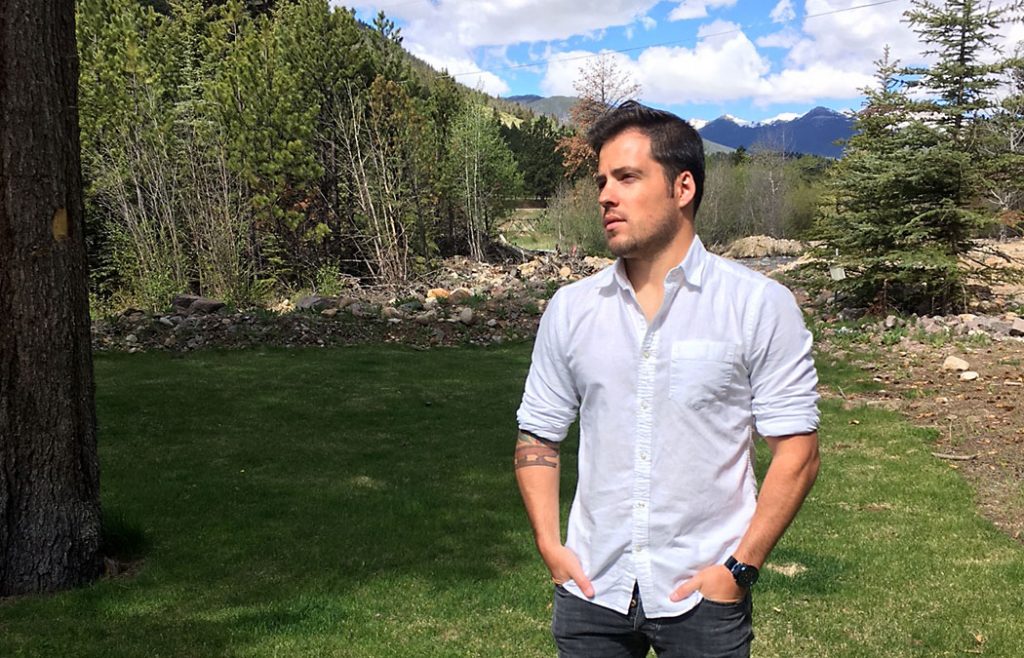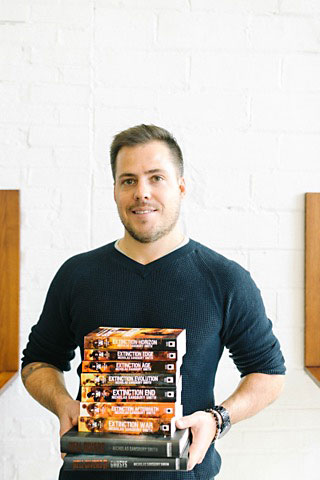
Nicholas Sansbury Smith’s day job involved keeping Iowans safe from disasters of many kinds. Despite the challenges, he carved out some time to become a novelist and then found success as an indie—or self-published—author.
In this interview, he talks about his path to writing success, as well as research for his Trackers series, the first book of which is a taut post-apocalyptic survival adventure blended with a murder mystery.
(This interview was arranged by a publicist from Amazon’s PR team.)
Rob Cline: You had a full-time (and I imagine quite demanding) career in Homeland Security and Emergency Management. What led to your decision to write a novel on top of those demands—and how did you find time to do it? And why did you decide to take the “indie” route instead of pursuing a traditional publisher?
Nicholas Sansbury Smith: Writing was always a passion, but it was also just a hobby. I wrote two novels in college and never really considered searching for a publisher. It wasn’t until 2013 that I became aware of Kindle Direct Publishing (KDP) and the Amazon service that allows authors to self-publish their stories. I was already reading dystopian and post-apocalyptic e-books and thought maybe I could publish the dystopian manuscript I wrote in college.
After talking to a successful local author, I decided that was exactly what I would do. About six months later, I published that book through KDP. I soon realized I needed to also learn how to market when the story didn’t do much in terms of sales.
I spent the next year writing a science fiction series while learning how to market by reading blogs and listening to podcasts on Amazon. My first publishing failure motivated me to figure out how to find success with the sales of the book after writing it.
It wasn’t easy. For most of my 10 years working for the government, I was in graduate school or working a second job, so I was used to the long hours that came with working at Homeland Security & Emergency Management Iowa (HSEMD) during the day and writing at night. I spent a lot of nights and weekends away from friends and family finishing my second novel. When I did, I self-published again. This sci-fi book, Orbs, went viral.
I wasn’t really tempted to go the traditional route until after I had success self-publishing. The reason was simple—I didn’t think my work was good enough at the time, and I was doing it as a hobby with low expectations, hoping to make some extra money and reach an audience that enjoyed my work. I had no idea my second book, Orbs, would sell so fast and so much. That book actually led me to a “big five” contract with Simon & Schuster and a top literary agent. I left my job at HSEMD about six months after Orbs came out.
Since then, I’ve continued to self-publish and work with other publishers, including Hachette (Orbit Books), Blackstone Publishing, Audible, and Recorded Books. I’ve hit the USA Today bestseller list, the New York Times bestseller list twice, and have sold over a million copies on Amazon and Audible alone. Never in my wildest dreams did I think I would see my books in airports or Barnes & Noble or have the top-selling book on Audible. Amazon and Kindle Direct Publishing helped make that happen.
What advice would you give to a new author considering the indie route?

First, write the best book you can. This should be your primary focus. Then research the market and decide how you’re going to publish, exclusive to Amazon (my recommendation) or wide (on other platforms like Nook, iBooks, etc.), and whether you’re going to launch with an audiobook or other format.
Next, come up with a launch plan that includes putting together a team of early advance reviewers for your advance reader copies (ARCs) and a marketing budget for Facebook and Amazon ads. You will also need to figure out what you’re going to sell your book for. There are many schools of thought on this, and you will want to do your research before setting a price. Networking and having a mentor are also keys to success.
Lastly, once you get settled into a publishing process, I highly recommend the hybrid model of self-publishing some books and going traditional with other books, if possible. That’s how I built a career that gives me the flexibility to really experience the best of both worlds.
Your Trackers series centers on an all-too-plausible electromagnetic pulse (EMP) attack that devastates the infrastructure of the United States. Tell me a little about your research—into EMP attacks, of course—but also into other important story elements like Native American folklore.
Some of my research was from experience working at HSEMD and, before that, in the state’s engineering office. I knew on a state level what was being done, and what wasn’t being done, but I didn’t know much about the federal level. I interviewed several federal employees and some friends in the military. I also spent a good amount of time researching what was being done to prepare for an EMP attack on a nationwide scale. The scenario I came up with in Trackers was the most plausible, in my opinion, but the truth is, we don’t really know exactly how much of an effect a massive EMP would have on cars and certain electronics.
The Native American folklore was something I added to the story to help make it even more unique from other EMP apocalyptic stories that were flooding the market at the time. Using my degree in American Indian studies from the University of Iowa, and my library of books on different tribes, I used real folklore stories and imbedded them in the story. I think most readers have enjoyed this second layer of realism.
